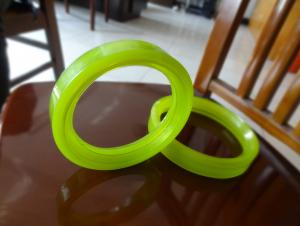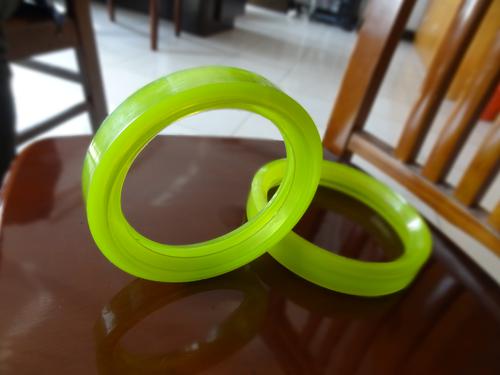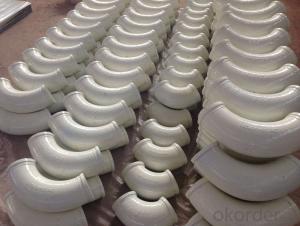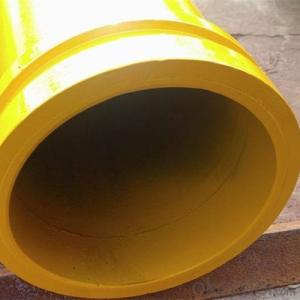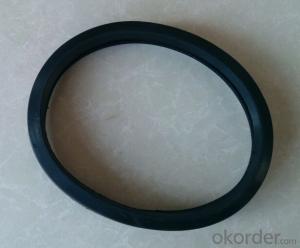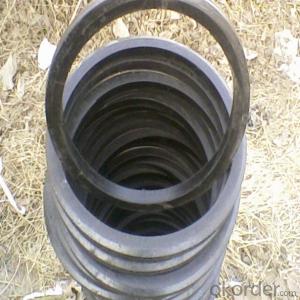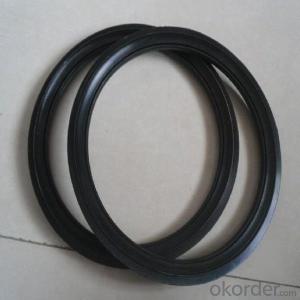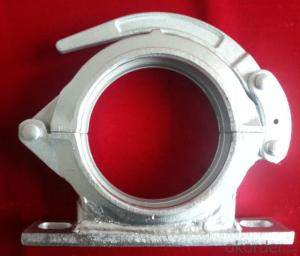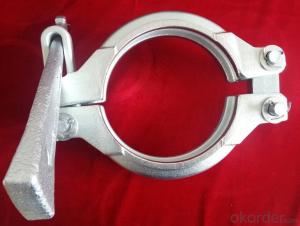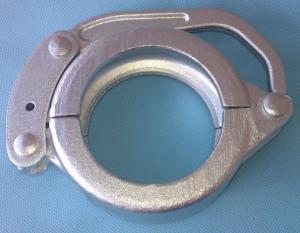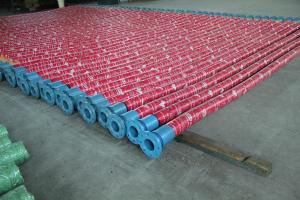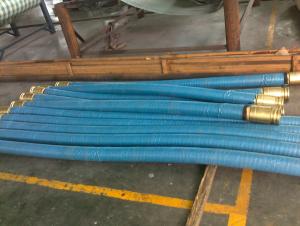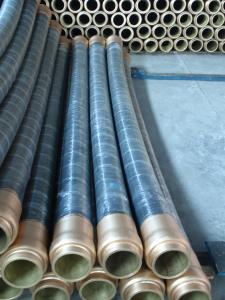High Quality Concrete Pump RUBBER SEAL DN125 DN150
- Loading Port:
- Tianjin
- Payment Terms:
- TT or LC
- Min Order Qty:
- 10 pc
- Supply Capability:
- 10000 pc/month
OKorder Service Pledge
OKorder Financial Service
You Might Also Like
Product Description:
Product Name: Rubber Seal DN125
1. Specification of Rubber Seal DN125
Materials: ruber
Inner Diameter: 125mm, 100mm
Outer Diameter: 148mm, 127mm etc.
Flange size: 148mm 127mm
Flange type: SK flange, ZX flange
Standards: ASTM A128-C
Color: Black
Notes: Total series of Concrete Pump Rubber Seal for different brand concrete pump (PUTZMEISTER, SCHWING, CIFA, SANY, ZOOMLION, IHI, KYOKUTO Etc)available from us, different length, different raw material pipe for customers choices.
2. Application of Rubber Seal DN125
Widely used on concrete pump truck, concrete placing boom, trailer concrete pump etc, for concrete delivery.
Our concrete pump delivery pipes have been successfully exported to many countries from 1998, Our main markets as below: Middle East, Southeast Asia, America, Brazil, Italy, Russia, South Africa etc
Aiming at the largest concrete pump parts manufacturer, and reliable, professional supplier in China, we can supply concrete pump elbows, delivery pipes, casting or forging couplings, end rubber hoses, rubber pistons, tungsten wear plates, delivery cylinders, and other hydraulic parts, one stop service for your concrete pump parts and accessory business.
3. Package and Delivery
All these put inot containers.
4. Production
Our rubber seals are made with advanced technology of rubber formula, rubber moulding,Baking, Etc, suitalbe for different size of pipe flanges.

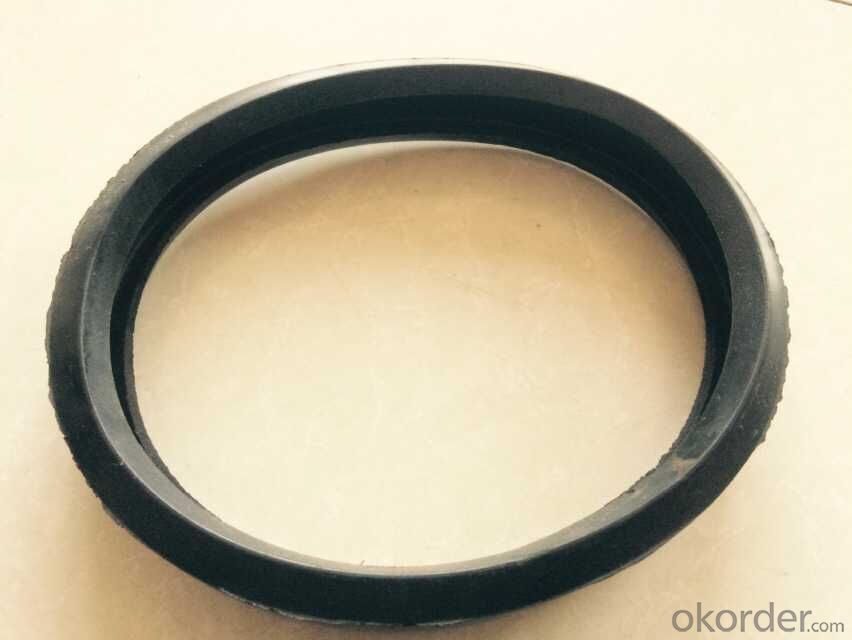
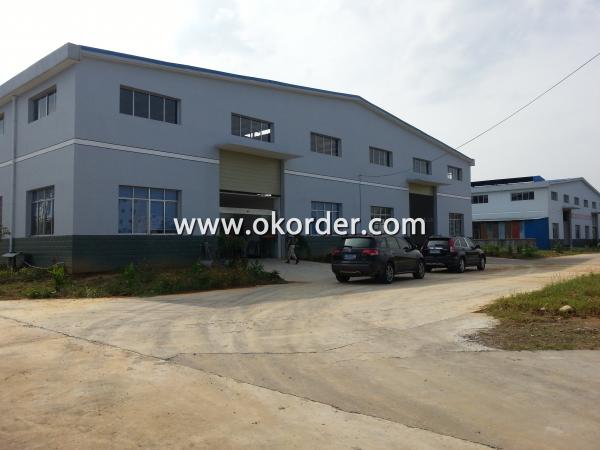
- Q: Are there any specific guidelines for the disposal of hydraulic fluids used in concrete pump spare parts?
- Yes, there are specific guidelines for the disposal of hydraulic fluids used in concrete pump spare parts. Hydraulic fluids contain various chemicals and contaminants that can be harmful to the environment if not disposed of properly. Here are some general guidelines to follow: 1. Check local regulations: Different regions may have specific laws and regulations regarding the disposal of hydraulic fluids. It is important to familiarize yourself with these regulations to ensure compliance. 2. Contain the fluid: Properly contain the hydraulic fluid to prevent leaks or spills during transportation. Use appropriate containers that are designed to handle hazardous materials. 3. Do not mix with other fluids: Do not mix hydraulic fluids with other substances, as this can complicate the disposal process and increase the environmental impact. 4. Find a licensed disposal facility: Locate a licensed facility that handles the disposal of hazardous waste. These facilities have the necessary equipment and expertise to handle hydraulic fluids safely. 5. Follow their instructions: When delivering the hydraulic fluid to the disposal facility, follow their specific instructions for drop-off. They may require certain labeling or documentation to ensure proper handling. 6. Consider recycling options: Depending on the type of hydraulic fluid used, recycling may be an option. Some facilities specialize in recycling hydraulic fluids, which can be a more environmentally friendly solution. 7. Educate your staff: Ensure that all personnel working with hydraulic fluids are aware of the proper disposal procedures and understand the importance of following them. By adhering to these guidelines, you can ensure the safe and responsible disposal of hydraulic fluids used in concrete pump spare parts, minimizing harm to the environment and complying with regulations.
- Q: How can a damaged concrete pump hopper affect the pumping process?
- The pumping process can be negatively impacted by a damaged concrete pump hopper in several ways. To begin with, efficiency and productivity can decrease when the hopper is damaged. The hopper's role is to hold and feed the concrete mixture into the pump. Any damage to the hopper can disrupt the continuous flow of concrete, leading to frequent interruptions in the pumping process. This causes delays and reduces the overall output of the pump. Furthermore, the quality of the concrete being pumped can be affected by a damaged hopper. The hopper is designed to ensure proper mixing and consistency of the concrete mixture before it is pumped. If the hopper is damaged, it may not effectively mix the concrete, resulting in inconsistencies in the mixture. This can lead to poor-quality concrete being pumped, compromising the structural integrity and durability of the final product. Additionally, a damaged hopper can pose safety risks for the workers involved in the pumping process. Sharp edges or loose parts on a damaged hopper can cause injury if not addressed properly. Moreover, if the hopper is not functioning correctly, it may cause clogs or blockages in the pump, leading to pressure build-up and potential accidents. Finally, maintenance and repair costs can increase due to a damaged hopper. An imperfect hopper may require frequent repairs or even replacement, which can be time-consuming and expensive. Regular maintenance and inspection of the hopper are crucial to identify any damages early on and prevent them from escalating into more significant issues. In conclusion, a damaged concrete pump hopper has significant implications for the pumping process, including reduced efficiency, compromised concrete quality, safety risks, and increased maintenance costs. Regular inspection, maintenance, and timely repairs are essential to ensure the smooth operation of the pump and the delivery of high-quality concrete.
- Q: Are there any specific maintenance practices for concrete pump spare parts?
- Yes, there are specific maintenance practices that should be followed for concrete pump spare parts. Firstly, it is important to regularly inspect the spare parts for any signs of wear or damage. This includes checking for cracks, leaks, or any other visible defects. If any issues are detected, the spare parts should be replaced or repaired immediately to prevent further damage. Secondly, it is crucial to clean the spare parts on a regular basis. Concrete pump spare parts often come into contact with cement, water, and other substances that can cause build-up and affect their performance. Regular cleaning will help remove any debris or residue, ensuring that the spare parts function optimally. Additionally, lubrication is an essential maintenance practice for concrete pump spare parts. Lubricating moving components such as bearings, seals, and pistons will help reduce friction and wear, extending the lifespan of the spare parts. It is important to use the correct lubricants specified by the manufacturer and follow their guidelines for application. Furthermore, proper storage of spare parts is also important for their maintenance. They should be stored in a clean and dry environment, away from any chemicals or other substances that could damage them. Spare parts should also be stored in a way that protects them from physical damage, such as being dropped or bumped. Lastly, it is recommended to follow the manufacturer's guidelines and recommendations for maintenance and replacement intervals. Regular servicing and inspections by qualified technicians can help identify any potential issues early on and prevent major breakdowns or failures. In conclusion, following specific maintenance practices such as regular inspection, cleaning, lubrication, proper storage, and adherence to manufacturer's guidelines are crucial for ensuring the optimal performance and longevity of concrete pump spare parts.
- Q: How much is the pump for a month?
- Remove the pump car monthly fuel maintenance consumption (about 10 thousand to 5000), calculate the monthly one of the clay, probably earn about 14 to 150 thousand net!
- Q: Are there any specific regulations or standards for the labeling and packaging of concrete pump spare parts?
- Concrete pump spare parts are subject to specific regulations and standards regarding their labeling and packaging. These regulations and standards aim to guarantee safety, proper handling, and ease of identification for these spare parts. A key regulation requires clear and legible labeling on the packaging of concrete pump spare parts. This labeling must include essential information such as the manufacturer's name, part number, description, as well as any specific instructions or warnings for handling and installation. This ensures that users can easily identify the spare parts and comprehend their purpose and correct usage. Furthermore, specific standards may exist for the packaging material utilized for concrete pump spare parts. These standards may demand the use of durable and protective packaging materials to prevent damage during transportation and storage. By doing so, the quality and functionality of the spare parts are preserved until they are ready for use. Moreover, regulations may be in place regarding the labeling and packaging of spare parts concerning safety. For instance, certain spare parts may necessitate special labeling or packaging to indicate the presence of hazardous materials or potential risks if mishandled. This is crucial for ensuring the safety of those handling the spare parts and for compliance with relevant safety regulations. In conclusion, the labeling and packaging of concrete pump spare parts are governed by specific regulations and standards to ensure proper identification, handling, and safety. These regulations and standards play a vital role in upholding a high level of quality and reliability for these spare parts within the construction industry.
- Q: How often should concrete pump lubrication systems be inspected and maintained?
- To ensure proper functioning and longevity, it is essential to regularly inspect and maintain concrete pump lubrication systems. The frequency of inspections and maintenance will vary depending on factors such as the pump type, usage, and manufacturer's recommendations. Typically, it is advised to conduct monthly inspections and maintenance of concrete pump lubrication systems. This regularity allows for early detection of potential issues or wear and tear that may require attention. Furthermore, routine inspections help identify signs of lubricant degradation or contamination, which can affect the system's efficiency and performance. During the inspection, it is crucial to check for leaks, damaged or worn-out components, and ensure adequate greasing of all lubrication points. Additionally, the lubrication system should be cleaned to eliminate any accumulated debris or contaminants. Apart from monthly inspections, certain maintenance tasks should be carried out at regular intervals. These tasks may include lubricant and filter changes, belt and hose adjustments or replacements, and checking the system's pressure and flow to ensure proper operation. It is important to emphasize that the manufacturer's guidelines and recommendations must always be followed for inspecting and maintaining concrete pump lubrication systems. These guidelines may provide specific instructions based on the pump type and model, as well as any unique requirements. By regularly inspecting and maintaining concrete pump lubrication systems, optimal performance can be ensured, downtime can be minimized, and the lifespan of the systems can be extended.
- Q: What is the function of a concrete pump hopper grate handle?
- The function of a concrete pump hopper grate handle is to provide a means for operators to easily lift and remove the grate from the hopper, allowing for inspection, maintenance, or cleaning of the pump's interior.
- Q: How can a damaged concrete pump piston affect the pumping efficiency?
- A damaged concrete pump piston can significantly affect the pumping efficiency by compromising the seal between the piston and cylinder. This can lead to leakages and loss of pressure, resulting in reduced pumping force and efficiency. Additionally, a damaged piston can cause irregular movements and vibrations, leading to instability and potential damage to other components of the pump. Overall, a damaged concrete pump piston can hinder the smooth flow of concrete, decrease output, and require more energy to operate, ultimately affecting the pumping efficiency.
- Q: What is the function of a concrete pump water pump?
- The primary role of a water pump in a concrete pump system is to provide water for various purposes. Its main responsibility is to ensure a continuous water flow to the concrete pump, which aids in the efficient mixing and pumping of concrete. By adding water when necessary during the pumping process, the water pump guarantees that the concrete mixture maintains the desired consistency. It plays a crucial role in controlling the hydration process of the cement, preventing it from drying out and becoming unworkable. Furthermore, the water pump also plays a vital role in cleaning the concrete pump system after use. It effectively flushes out any excess concrete residue or debris that may have accumulated inside the pump, thus ensuring its optimal operational condition. To summarize, the concrete pump water pump functions to supply water for concrete mixing, maintain the desired consistency, and clean the concrete pump system.
- Q: How does a concrete pump clamp work?
- An integral part of a concrete pump is the concrete pump clamp, which is utilized to securely fasten and stabilize the concrete delivery pipeline. Its function is to firmly grasp the pipeline, eliminating any potential movement or leakage throughout the concrete pumping procedure. Typically comprised of two primary components, the concrete pump clamp consists of the clamp body and the wedge. The clamp body, constructed from durable steel, possesses a curved structure tailored to the pipeline's shape. Equipped with bolts or knobs, it can be tightened or loosened to attach the clamp to the pipeline. In contrast, the wedge is a metal piece that is inserted into the clamp body. Its purpose is to apply pressure to the pipeline when the clamp is tightened. By manipulating the bolts or knobs, the wedge is pushed deeper into the clamp body, effectively squeezing the pipeline and establishing a secure grip. The secure grip achieved by the concrete pump clamp is essential as it guarantees a seamless and uninterrupted flow of concrete without any leaks or disruptions. It upholds a consistent and steady movement of concrete from the pump to the desired destination. Furthermore, the clamp contributes to the stability of the pipeline, preventing any shifting or displacement during the pumping process. In summary, the concrete pump clamp assumes a crucial role in the efficient and safe operation of a concrete pump. It ensures the secure placement of the concrete delivery pipeline, facilitating a smooth and uninterrupted concrete pumping process.
Send your message to us
High Quality Concrete Pump RUBBER SEAL DN125 DN150
- Loading Port:
- Tianjin
- Payment Terms:
- TT or LC
- Min Order Qty:
- 10 pc
- Supply Capability:
- 10000 pc/month
OKorder Service Pledge
OKorder Financial Service
Similar products
Hot products
Hot Searches
Related keywords
